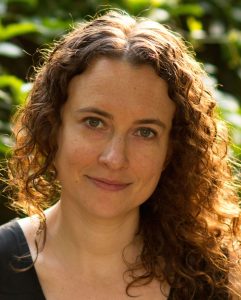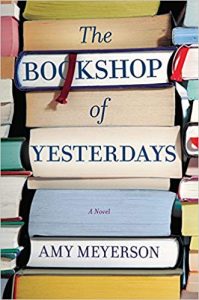BEHIND THE SCENES IN THE BOOKSHOP OF YESTERDAYS WITH AUTHOR AMY MEYERSON

In my review of The Bookshop of Yesterdays in January, I talked about the novel’s complex interweaving of different types of stories, including a mystery, an adventure story, a love story, and a tribute to literature. This month I’m pleased to have Bookshop’s author, Amy Meyerson, tell us some of how she created this bestselling novel, which will be translated into nine languages. Amy teaches in the writing department at the University of Southern California, where she completed her graduate work in creative writing. She’s been published in numerous literary magazines and currently lives in Los Angeles.
SW. I really enjoyed the clues in the story’s scavenger hunts. How did you approach writing the ones that weren’t direct quotes?
AM. There are three different scavenger hunts in the novel, two from Miranda’s childhood and the one her uncle sends her on in the present day of the book. The clues from her youth are simpler, so I started with those, reading tons of riddles for children. Once I got a handle on the rhythm of riddles, I tackled the more complicated riddles Miranda’s uncle leaves for her as an adult. The answers to those clues are all from famous novels, so I found a few choice details from the novels as well as the authors’ biographies to include in the riddles. After I composed what I hoped was a clever riddle, I sent the riddle to a few friends who are really good at trivia. If they figured out the answers too quickly, I amended the clue. As Miranda notes in the novel, riddles should be simple. The cleverer ones are better at hiding their simplicity. So, that was my aim–something that seemed challenging while you were trying to solve it, then obvious once you did. Miranda struggles with a few of the clues, so my hope is that the reader does, too.
SW. For the clues that were quotes, how did you find such appropriate passages from so many different sources of literature?
AM. I picked the novels that comprise the scavenger hunt very deliberately. Each novel sends Miranda to talk to someone from her uncle’s past, so I wanted the novel to accomplish three things: 1) the narrative or themes of the novel had to resonate with the story Miranda was going to be told; 2) the novel had to be one that readers would know and love; and 3) it had to have a passage that I could quote that would convey to Miranda how to interpret the story she was about to be told. To find the right books, I made a list of five novels I thought might work for each step of the scavenger hunt. Then, I reread them. Since I already knew what I needed each novel to accomplish, I’d mark passages as I read. It was painstaking but rewarding. I got to revisit a lot of wonderful novels.

SW. There are so many parts to this story. Which aspect (mystery, family relationships, tie in to literature, or something else) attracted you first?
AM. I tend to come up with a premise first and characters later. This novel started with a question: what can you know about a person based on what they leave behind–intentionally and not–in books. I’d read a really interesting essay in The New York Times Book Review about the strange items people have found in books. It listed everything from love notes to a baby’s tooth to dead bugs purposely crushed between the pages. I was struck by the idea that you could tell a lot about someone based on what they abandon in books. Then, I started to imagine who would leave items intentionally in books and why. The scavenger hunt grew from there, the motivation for the scavenger hunt–the family estrangement–followed, then the characters.
SW. The story shows respect for the influences of history and literature. How do you think these two forces impact people today?
I gave the novel the epigraph, “What’s past is prologue,” from The Tempest because it’s a primary theme in the novel. I also think it’s a good answer to your question here. Although the phrase meant something different in the play, in popular culture it’s come to mean that the present is shaped by events of the past. That’s why history is so important. In my writing, I think about this idea a lot in terms of personal history. I’ve only recently become interested in my family’s history, and it worries me, all the things I’ll never be able to know. I think it’s important to ask questions of older generations while we can still get answers. Otherwise, we have to rely on official histories and items that are left behind.
I think a lot of people underestimate the role literature plays in our society today. There’s this constantly perpetuated myth that people aren’t reading. It just isn’t true. Books and publishing aren’t dying. All sorts of people love to escape into books. I think that escape is especially important today.
SW. In what ways is the main character, Miranda, like you and in what ways is she different?
AM. Miranda and I are pretty different. I’ve developed a greater interest in American history by embodying her, but she’s a little lost in ways I don’t think I am. I do, however, think we sometimes respond emotionally to situations in similar ways.
SW. Which character was the easiest for you to create?
AM. I think supporting characters are always the easiest to create because you see them externally, the way they present themselves to the world. With main characters, you have to have a greater understanding of their motivations and their private lives. I really loved all the characters in the bookshop, the people from Billy’s past that Miranda met along her journey. They came to me pretty swiftly.
SW. Which character was the hardest for you to create?
AM. I struggled the most with Miranda’s mother, Susan. For much of the novel, the reader doesn’t understand her motivations, which makes her seem evasive and potentially unlikeable. Once the reader understands why Susan has been cagey with Miranda, my hope is that the reader has empathy for her. It was a challenge, though, not to make her the villain of the novel. She’s put in an impossible position and does the best she can. Like the rest of us, she’s human.
SW. As people learned about your book, what unexpected things happened along the way?
I’ve gotten many more letters from readers than I’d ever expected, which has been so heartening. As a reader, I’ve never sent fan mail to an author. Now, I wish that I had. It means so much to me to hear from my readers, particularly those who have been personally affected by the novel. Several readers have told me that my novel helped them get over their grief and that it inspired them to reach out to a family member they were estranged from. I don’t think there’s better praise than that.
The other unexpected thing that’s happened is that I’ve become part of a larger community of writers. I have my writer friends from graduate school and writing groups, but since I started doing pre-publication publicity for the novel, I’ve been attending conferences, readings, and festivals where I’ve met all sort of writers I’ve admired from afar. I don’t know why, but I hadn’t anticipated publishing also meant joining the world of writers. It’s been a treat.
SW. What do you hope readers remember about The Bookshop of Yesterdays?
AM. The most immediate thing I wanted readers to take away from my novel is that it’s a celebration of books and reading. I hope it feels that way to readers. I also hope that they see it as a novel about forgiveness and that it causes them to reflect on any strained relationships they may have in their lives. It’s never too late to reconcile.
SW. As a reader, what makes a story memorable for you?
AM. I have a horrible memory when it comes to books I’ve read. I’ll remember why I liked a novel and what it’s about, but I rarely remember what happens or how a book ends. So, I think it’s something more abstract that makes a novel memorable for me. I love the way reading a specific novel makes me feel. I love the way it’s written. I love a moment that I hold onto, even if I forget the events surrounding it.
SW. What are you working on now?
I’m working on a new novel that will publish in spring or summer 2020. It’s another family mystery, this time centering on a historic diamond called the Florentine Diamond. The Florentine Diamond is the fifth largest yellow diamond in the world (137 carats) and was part of the Austrian Crown Jewels until the empire fell in 1919. When the royal family fled Austria to Switzerland, they brought the crown jewels with them, but the Florentine didn’t arrive with the other gemstones. It hasn’t been seen since. In my novel, it turns up almost one-hundred years later in a holocaust survivor’s jewelry box in Philadelphia after she passes away. Her family has to figure out how she got the diamond and whether it legally belongs to them. It’s been such a fun book to research, and I can’t wait to share it with readers.
Sally Whitney
Sally Whitney is the author of When Enemies Offend Thee and Surface and Shadow, available now from Pen-L Publishing, Amazon.com, and Barnesandnoble.com. When Enemies Offend Thee follows a sexual-assault victim who vows to get even on her own when her lack of evidence prevents police from charging the man who attacked her. Surface and Shadow is the story of a woman who risks her marriage and her husband’s career to find out what really happened in a wealthy man’s suspicious death.
Sally’s short stories have appeared in magazines and anthologies, including Best Short Stories from The Saturday Evening Post Great American Fiction Contest 2017, Main Street Rag, Kansas City Voices, Uncertain Promise, Voices from the Porch, New Lines from the Old Line State: An Anthology of Maryland Writers and Grow Old Along With Me—The Best Is Yet to Be, among others. The audio version of Grow Old Along With Me was a Grammy Award finalist in the Spoken Word or Nonmusical Album category. Sally’s stories have also been recognized as a finalist in The Ledge Fiction Competition and semi-finalists in the Syndicated Fiction Project and the Salem College National Literary Awards competition.
- Web |
- More Posts(67)